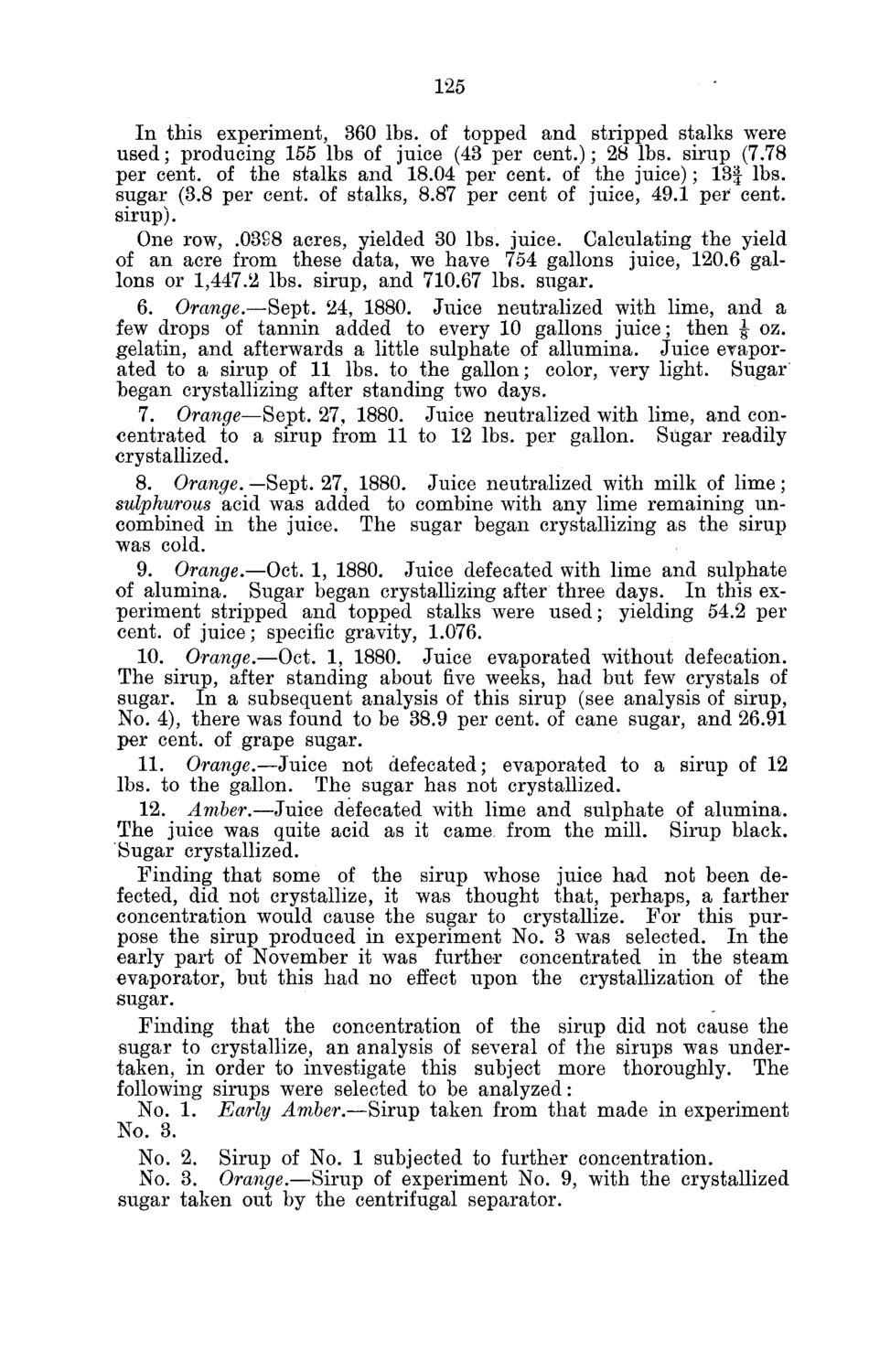| |
| |
Caption: Board of Trustees Minutes - 1880
This is a reduced-resolution page image for fast online browsing.

EXTRACTED TEXT FROM PAGE:
125 In this experiment, 360 lbs. of topped and stripped stalks were used; producing 155 lbs of juice (43 per cent.); 28 lbs. sirup (7.78 per cent, of the stalks and 18.04 per cent, of the juice); 1 3 | lbs. sugar (3.8 per cent, of stalks, 8.87 per cent of juice, 49.1 per cent, sirup). One row, .03S8 acres, yielded 30 lbs. juice. Calculating the yield of an acre from these data, we have 754 gallons juice, 120.6 gallons or 1,447.2 lbs. sirup, and 710.67 lbs. sugar. 6. Orange.—Sept. 24, 1880. Juice neutralized with lime, and a few drops of tannin added to every 10 gallons juice; then | oz. gelatin, and afterwards a little sulphate of allumina. Juice evaporated to a sirup of 11 lbs. to the gallon; color, very light. Sugar began crystallizing after standing two days. 7. Orange—Sept. 27, 1880. Juice neutralized with lime, and concentrated to a sirup from 11 to 12 lbs. per gallon. Sugar readily crystallized. 8. Orange. —Sept. 27, 1880. Juice neutralized with milk of lime; sulphurous acid was added to combine with any lime remaining uncombined in the juice. The sugar began crystallizing as the sirup was cold. 9. Orange.—Oct. 1, 1880. Juice defecated with lime and sulphate of alumina. Sugar began crystallizing after three days. In this experiment stripped and topped stalks were used; yielding 54.2 per cent, of juice; specific gravity, 1.076. 10. Orange.—Oct. 1, 1880. Juice evaporated without defecation. The sirup, after standing about five weeks, had but few crystals of sugar. In a subsequent analysis of this sirup (see analysis of sirup, No. 4), there was found to be 38.9 per cent, of cane sugar, and 26.91 per cent, of grape sugar. 11. Orange.—Juice not defecated; evaporated to a sirup of 12 lbs. to the gallon. The sugar has not crystallized. 12. Amber.—Juice defecated with lime and sulphate of alumina. The juice was quite acid as it came, from the mill. Sirup black. Sugar crystallized. Finding that some of the sirup whose juice had not been defected, did not crystallize, it was thought that, perhaps, a farther concentration would cause the sugar to crystallize. For this purpose the sirup produced in experiment No. 3 was selected. In the early part of November it was further concentrated in the steam evaporator, but this had no effect upon the crystallization of the sugar. Finding that the concentration of the sirup did not cause the sugar to crystallize, an analysis of several of the sirups was undertaken, in order to investigate this subject more thoroughly. The following sirups were selected to be analyzed: No. 1. Early Amber.—Sirup taken from that made in experiment No. 3. No. 2. Sirup of No. 1 subjected to further concentration. No. 3. Orange.—Sirup of experiment No. 9, with the crystallized sugar taken out by the centrifugal separator.
| |